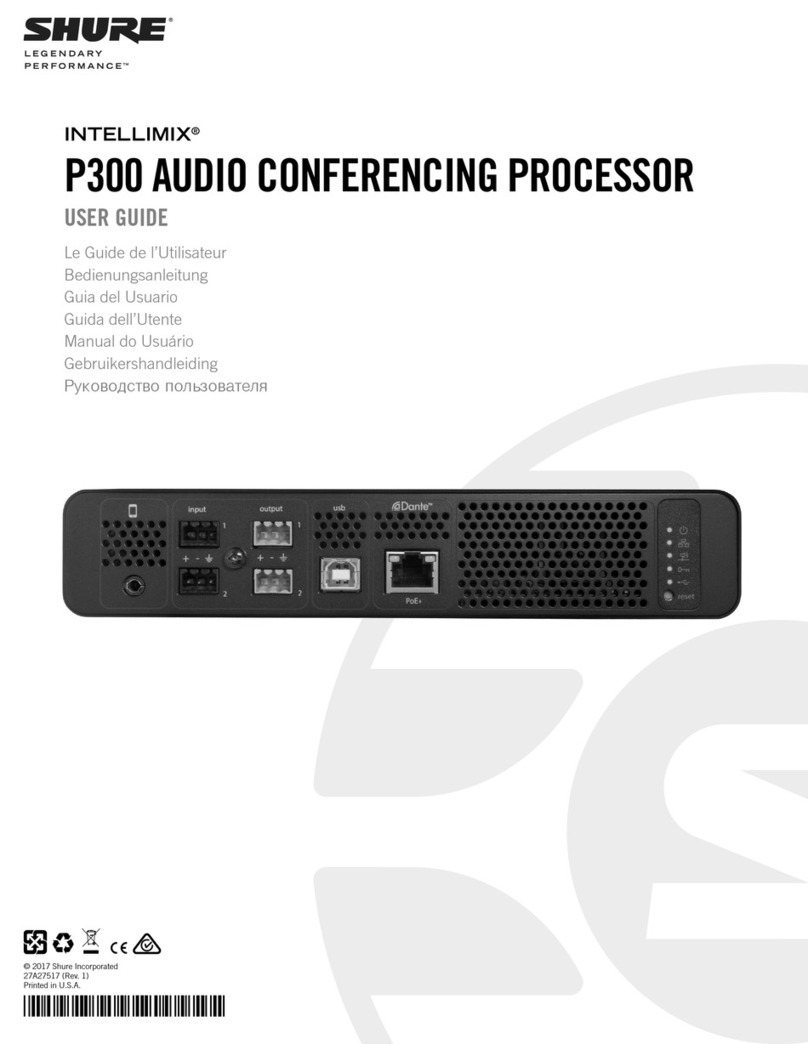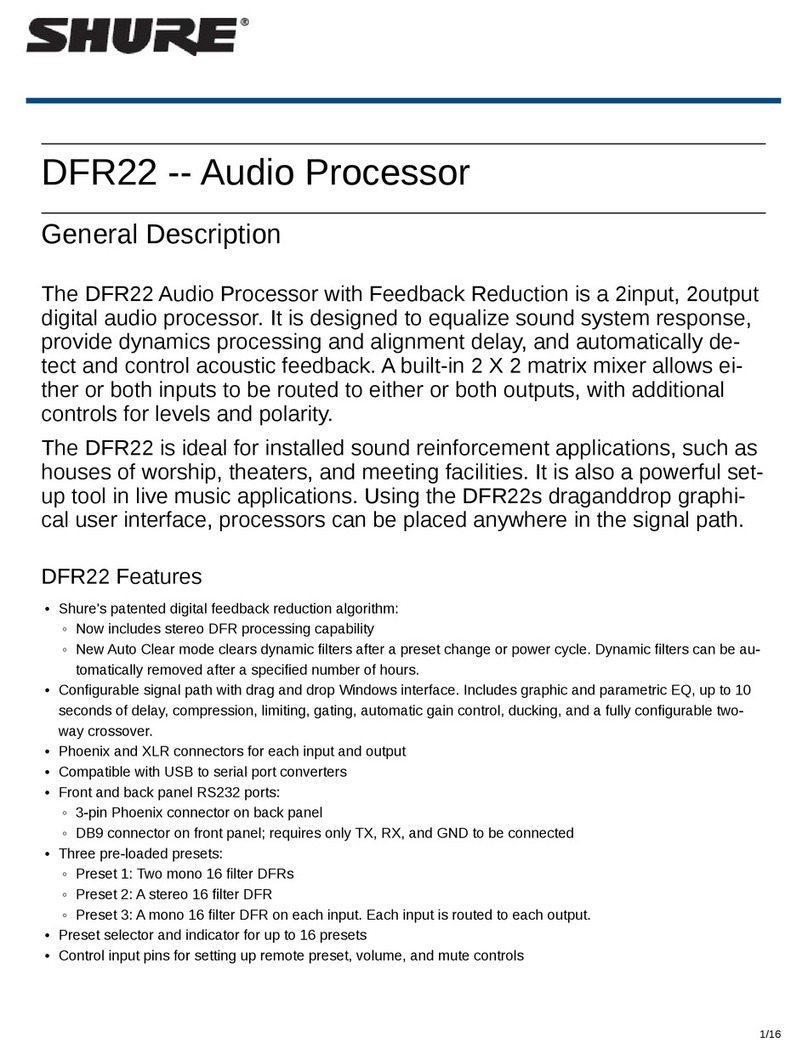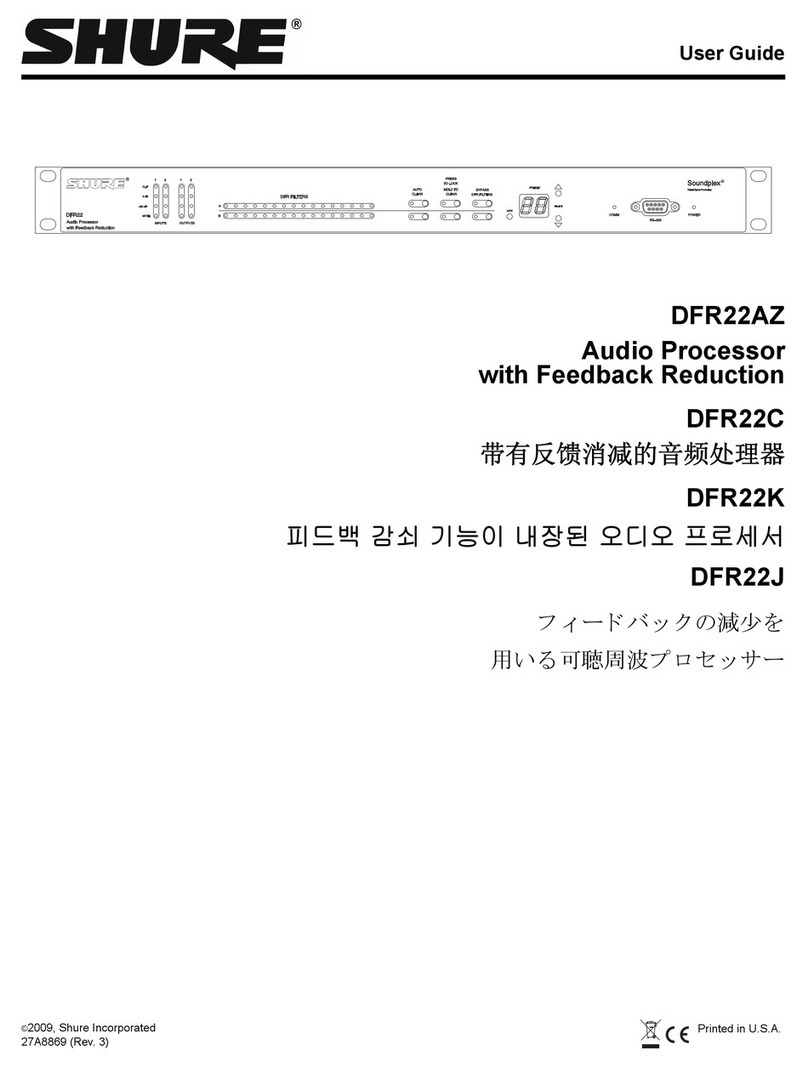CONTENTS
PAGE
Introduction
..................................
2
General Description
...........................
3
Systemsetup
.................................
4
Multiple Inputs
..............................
4
Locating Speakers
...........................
4
Connections
................................
5
Inputs
...................................
5
Outputs
..................................
5
Basic System
...........................
5
Complete System
.......................
5
Operation
..................................
6
Pushbutton Controls
.......................
6
Rotary Controls
...........................
6
...........................
Remote Control 7
Mono EnhanceAdjust
......................
7
System Balance
...............................
8
Phasing
......................................
8
Graphic Display
...............................
9
Program Material
..............................
9
Trouble Shooting Guide
........................
10
Specifications
................................
11
Safety Instructions
............................
11
lY
TRODUCTION
2ongratulations. Your purchase of a Shure HTS5000
Surround Audio Processor will provide years of listen-
ing pleasure while serving as the main control compo-
nent of your HomeTheater Sound System. Unlike other
surround sound audio products,the HTS5000iscapable
of recreating in your home the audio experience of the
very best motion picture theaters with Dolby Stereo1
equipment. The latest techniques in analog and digital
signal processing electronics have been employed in
the HTS5000 to duplicate the performance of profes-
sional Dolby stereo motion picturetheater equipment.
If you are quite familiar with surround sound, Dolby
Surround, and the Dolby Stereo process, you may wish
to skip ahead in the manual and set up your system us-
ing the block diagrams shown in Figures
6
and
7.
Initial
control settings are discussed starting on page
6,
and
special adjustments are described on page 8.
Since the application of Dolby Stereo to the home en-
vironment is a relatively new concept to most people,
we encourage you to read the entire manual before set-
ting up and enjoying your HTS5000. Several sections
have been included beyond normal system setup and
operation to help maximizeyour listening pleasure, and
broaden your understanding of this exciting new con-
cept.
With any new concept, terminology is often the
source of much confusion. Because a surround sound
system can involve as many as six amplifier and
loudspeaker channels and is designed to be used with
new types of program material, a few definitions may be
helpful:
00
Dolby Stereo-
Dolby Stereo is the term used to
describe a motion picture audio process that results in
a surround sound experience in the theater. The basic
elements of such a system are three loudspeaker chan-
nels behind the screen (Left Front, Center Front, and
Right Front) and a fourth to the sides or behind the
listener. This process was developed by Dolby Labora-
tories and involves sophisticated techniques to encode
and decode four audio channels on stereo film sound
tracks. Dolby Stereo has become the most widely user'
process for producing stereo motion picture soun,.
tracks in the world with over 700 movies made to date.
Movies made using this process display the Dolby
Stereo logo during the credit portion of the film. With
the growth of consumer audiolvideo technology, this
process is now being applied to music video and televi-
sion drama production.
00
Dolby Surround
-
Dolby Surround is the term us-
ed to describe systems that allow Dolby Stereo sound
tracks to be played back in the home. All products that
carry the Dolby Surround logo must meet certain
minimum technical requirements established by Dolby
Laboratories. The Shure HTS5000goes beyond these re-
quirements by a wide margin to significantly increase
the listening experience in the home as compared to
basic Dolby Surround processors. Consumer program
material that contains Dolby Stereo sound tracks will
soon be identified with the Dolby Surround logo. (See
section on Program Material for more details).
Before getting into the specifics of the HTS5000and
how to set it up in your home, it is worthwhile to con-
sider the audio-visual aspects of a total home theater
system in general terms:
Inthe theater, the large size of the movie screen con-
tributes greatly to the participatory quality of the ex-
perience. An effect of the big screen is to overwhelm
other stimuli, precluding attention to offscreen happen-
ings.
The viewer is much closer to the home tv screen thai
the moviegoer to the theater screen. As a result, the
home screen need not be absolutely as large as the
movie screen to rivet the attention comparably. But, the
larger the screen, the more participatory the experience
will be.
The largest available homescreens are usedwith pro-
jection tv systems which vary in color quality, resolu-
tion, brightness and clarity of the off-axis image. The
most successful surround sound home televiewing ex-
perience will be with a system that has a bright on- and
off-axis picture, high resolution, and excellent color ac-
curacy. In some viewing rooms, these qualities may be
achievable with a
19-
or 25-inch television receiver; in
most cases, a projection tv will be preferable.
A high performance audio system contributes as
much as the large screen to the participatory quality of
the theatre experience. To duplicate this quality in the
home, the system must be capable of producing high
sound pressure levels not only in the front but also in
the subwoofer (or low frequency) and surround chan-
nels. The use of a center channel loudspeaker also
becomes very important in maintaining proper audio
perspective for all viewers. In order to obtain the op-
timum listening experience using the HTS5000, it is im-
portant to select loudspeakers and amplifiers that are
capableof producing adequate sound levels. As a basis
for comparison, a modern motion picture theater
capable of showing Dolby Stereo movies is set up to
generate maximumsound pressure levels of 108dB SPL
at an ideal viewing position.
1.
Manufactured under license from Dolby Laboratories Licensing Cor-
poration. Additionally licensed under one or more of the following
patents:
U.S.
numbers 3,632,886,8,6,972, and 3,959,590; Canada
numbers 1,004,603and 1,037,877. "Dolby" and the double-D symbol are
trademarks of Dolby Laboratories Licensing Corporation.




































